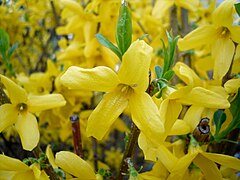|
Oleaceae > |
If this plant info box on watering; zones; height; etc. is mostly empty you can click on the edit tab and fill in the blanks!
Forsythia (pronounced /fɔrˈsɪθiə/)[1] is a genus of flowering plants in the family Oleaceae (olive family). There are about 11 species, mostly native to eastern Asia, but one native to southeastern Europe. The common name is also Forsythia; the genus is named after William Forsyth.[2][3][4]
They are deciduous shrubs typically growing to a height of Template:Nowrap Template:Nowrap and, rarely, up to Template:Nowrap with rough grey-brown bark. The leaves are opposite, usually simple but sometimes trifoliate with a basal pair of small leaflets, and range from Template:Nowrap in length and, rarely, up to Template:Nowrap long; the margin is serrated or entire. The flowers are produced in the early spring before the leaves, bright yellow with a deeply four-lobed corolla, the petals joined only at the base. These become pendant in rainy weather thus shielding the reproductive parts. The Forsythia's flowers are impressive with the fact that they are able to produce lactose (the milk sugar). Lactose is very rarely established in other natural sources except milk. The actual fruit is a dry capsule, containing several winged seeds.[2][5]
Read about Forsythia in the Standard Cyclopedia of Horticulture
|
|---|
|
Forsythia (after William Forsyth, prominent English horticulturist, director of the Royal Garden at Kensington, 1737-1804). Oleaceae. Golden- Bell. Shrubs grown for their wealth of bright yellow flowers appearing early in spring, also for their handsome dark green foliage. Deciduous: lvs. opposite, petioled, serrate or entire, simple or partly 3-parted to 3-foliolate: fls. 1-6, axillary, pedicelled, heterostylous; calyx and corolla deeply 4-lobed, lobes of the corolla oblong, longer than the campanulate tube; stamens 2, included, inserted at the base of the corolla; ovary superior; style slender with 2-lobed stigma: fr. a 2- celled, dehiscent caps, with many winged seeds.— Four species in China, Japan and S. E. Eu. The golden-bells are highly ornamental, free-flowering shrubs, with simple or ternate leaves and showy yellow flowers, borne in great profusion along the slender branches in early spring before the leaves. They belong to the showiest early - flowering shrubs, and showy yellow flowers, borne in great profusion along the slender branches in early spring before the leaves. They belong to the showiest early-flowering shrubs, and have handsome, clean foliage, remarkably free from insects or fungi, remaining unchanged until late in fall. The upright forms are well adapted for the borders of shrubberies and the pendulous form for covering walls, fences, arbors or porches. They grow in almost any kind of garden soil, and are hardy North except F. viridissima, which is somewhat tenderer. Propagation is readily by greenwood and hardwood cuttings; also by seeds. The branches of the pendulous form often take root at the tips when touching the ground, and send forth vigorous shoots, like some brambles or the walking-fern. F. giraldiana, Lingelah. Upright shrub: lvs. elliptic to oblong, long-acuminate, broadly cuneate at the base, entire or serrulate, glabrous or hairy on the veins beneath, 2-5 in. long: fls. short-stalked: caps, ovoid with a long and slender beak. N. W. China. CH
|
Cultivation
- Do you have cultivation info on this plant? Edit this section!
Propagation
- Do you have propagation info on this plant? Edit this section!
Pests and diseases
- Do you have pest and disease info on this plant? Edit this section!
Species
The 6 species arewp:
- Forsythia europaea Degen & Bald. Balkans in Albania and Serbia.
- Forsythia giraldiana Lingelsh. Northwest China.
- Forsythia japonica Makino. Japan.
- Forsythia likiangensis Ching & Feng ex P.Y.Bai. Southwest China.
- Forsythia mandschurica Uyeki. Northeast China.
- Forsythia mira M.C.Chang. North central China.
- Forsythia koreana (Nakai) T.B.Lee. Korea.
- Forsythia ovata, from Korea
- Forsythia suspensa, from China
- Forsythia togashii H.Hara. Japan (Shōdoshima).
- Forsythia viridissima, from China
Hybrids:
- Forsythia × intermedia. Garden hybrid between F. suspensa and F. viridissima.
- Forsythia × variabilis (F. ovata × F. suspensa) have been produced in cultivation.
Gallery
If you have a photo of this plant, please upload it! Plus, there may be other photos available for you to add.
A 50-year old Forsythia shrub in Maryland
References
- Standard Cyclopedia of Horticulture, by L. H. Bailey, MacMillan Co., 1963
External links
- w:Forsythia. Some of the material on this page may be from Wikipedia, under the Creative Commons license.
- Forsythia QR Code (Size 50, 100, 200, 500)
